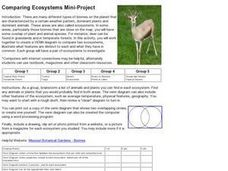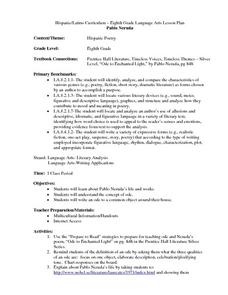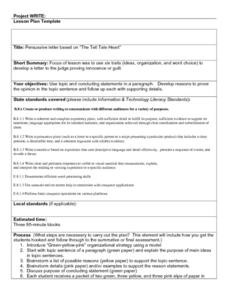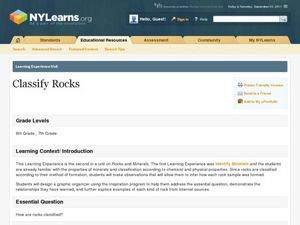Curated OER
Identifying Sea Ice
Students study different types of sea ice and interview an Yupik elder or local hunter. For this sea ice lesson, students study the native language for sea ice terms. They interview an elder from Alaska's northern coast about their...
Curated OER
Lesson 4- Arthur Meets the President
Students create a pamphlet. In this story evaluation instructional activity, students complete a story evaluation on Washington, D.C., create a pamphlet on Washington, D.C., and then discuss the most interesting thing they learned.
Curated OER
Comparing Ecosystems
Students, in groups, research two biomes. They create a Venn diagram and include the characteristics of each biome, placing similar features in the overlapping area of the circles.
Curated OER
Using Geometric Shapes To Make Patterns
Sixth graders explore the use of shapes to create geometric patterns. they start with a simple example of dividing shapes in half to create two new ones. This can be extended to creating intricate patterns.
Curated OER
How Resourceful Are You?
Students investigate the concept of resources. They differentiate between natural, human, and capital resources. Prior to the lesson the students need to build background knowledge of goods, services, needs, and wants. They create a...
Curated OER
Pablo Neruda
Eighth graders explore the life and works of Pablo Neruda. They complete an author map concerning his personal and professional life. Students identify the key components of an ode. They write an ode to a common object around their...
Curated OER
Order My Steps
Students organize and sequence their writing ideas using different graphic organizers. They use the ideas to write a story that takes place over two days.
Curated OER
Treasure Hunt
Students actively search a the ground outside and find several types of leaves, lichen, feathers and trash. They place items into journals, write entries, draw pictures and ask questions about the items found on their exploration.
Curated OER
Inferring Themes
Fifth graders practice making inferences on various types of reading material. As a class, they develop a definition of the word "theme" and discuss themes for some of their favorite stories. They use the context of the reading...
Curated OER
An Exploratory Approach to the Teaching of French in the Middle School
Students review the most recent vocabulary list of French words. Using literature by Victor Hugo and Guy de Maupassant, they discover the history and culture of France. Using a map and the text, they locate the cities and regions of...
Curated OER
Persuasive Letters and The Tell Tale Heart
Pupils write persuasive letters based on "The Tell Tale Heart." They brainstorm topic sentences, main ideas, and details. They analyze the character and determine if he is innocent or guilty. They create a map listing their reasons to...
Curated OER
Volcano!-Is That a Volcano on Your Plate?
Learners explore how and where volcanoes form. They also explore how the interactions between oceanic and continental crust create volcanoes and other mountains and earthquakes in a simulation activity using cardboard of two thicknesses.
Curated OER
Worksheet 3 Vocabulary Review: Words That Mean the Same
In this synonyms instructional activity, students read 10 sentences and analyze the word in bold type. From two choices, students circle the letter of a word or phrase that means the same.
Curated OER
Introducing Biodiversity
Students investigate biodiversity by creating reports with their classmates. In this ecosystem lesson, students utilize the Internet to research the different types of life in our environment and different locations around the world....
Curated OER
Shipwreck Mystery
Students study web pages on a shipwreck then locate where this took place on a map. In this marine archaeologist lesson students examine what clues archaeologists use to find the location of a shipwreck and what they might find.
Curated OER
Lesson 1 Walk Through and Notes
Fourth graders take notes on a class discussion. In this economy instructional activity students discuss Indiana's economy over a span of history. The students use a map and a timeline.
Curated OER
Classify Rocks
Students classify different types of rocks. For this earth science lesson, students test different rock samples and construct a chart to record observations. They create a concept map that answers essential questions.
Curated OER
China: How to Put Some "Tang" in Your Medieval Dynasties
Fourth graders label the countries that border China and the physical features of Asia. They discuss the physical features of Asia and label them on the other map.
Curated OER
Water Walk
Students follow the appropriate sampling protocol and take two measurements of a local water source. These measurements are Transparency and Temperature. This info about local land use and/or water chemistry issues may require further...
Curated OER
Birds of the Northeast
Students identify several common birds through field observations, preserved specimens and personal experience. They classify the species and choose one to research. They draw a migration map and participate in a project that benefit...
Curated OER
Garbage/Solid Waste Disposal
Young scholars examine the problem of solid waste disposal in modern society. They decide on a site for waste disposal. They investigate the many different types of waste that need to be dealt with. They participate in three learning...
Curated OER
From Graphic Organizer to Comparison
Fifth graders brainstorm a variety of topics for writing. As a class, learners create four types of graphic organizers on selected topics. They discuss how to use graphic organizer in constructing a written paragraph.
Curated OER
Zulu King, Zulu King
Students listen to story Brown Bear, Brown Bear, brainstorm everything they know about Mardi Gras, create pages relating to Mardi Gras for class book, type information on computer, play slide show, and take turns reading their books.
Curated OER
Los Trenes de Espa¿¿a
High schoolers identify and read correctly the symbols of a Spanish train schedule. Using maps, they identify and locate major cities and landforms of Spain and practice using a twenty-four hour clock. Using the internet, they navigate...

























